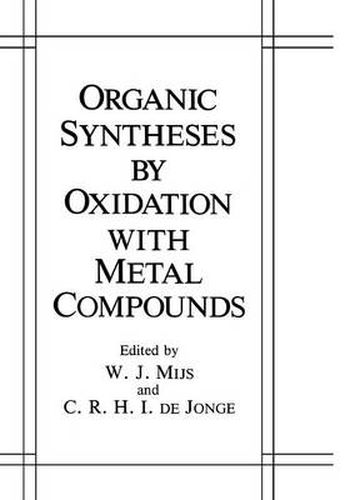Readings Newsletter
Become a Readings Member to make your shopping experience even easier.
Sign in or sign up for free!
You’re not far away from qualifying for FREE standard shipping within Australia
You’ve qualified for FREE standard shipping within Australia
The cart is loading…






This title is printed to order. This book may have been self-published. If so, we cannot guarantee the quality of the content. In the main most books will have gone through the editing process however some may not. We therefore suggest that you be aware of this before ordering this book. If in doubt check either the author or publisher’s details as we are unable to accept any returns unless they are faulty. Please contact us if you have any questions.
This book is concerned with the synthetic aspects of oxidation reactions involving metal compounds. which are readily available or easy to prepare. The sequence followed in the chapters is as follows: a general introduction. a limited treatment of reaction mechanisms to serve as a basis for synthesis. and scope and limitations of the oxidant system. mostly in terms of substrate and product classes. Finally, at the end of each chapter. representative synthetic procedures are given together with relevant experimental considerations. A general table is included as an appendix. This contains substrate classes and resulting product classes, referring to the oxidative procedures in the chapters. The table provides the synthetic organic chemist with a quick overview of oxidation possibilities with metal-contain ing oxidants, enabling him to select the right method for his purpose. The editors hope that not only organic research chemists in industry and at universities, but also advanced undergraduate and graduate students in organic chemistry, will find this book a useful guide in the design, understanding, and practical performance of oxidative organic syntheses. The editors are grateful to the authors not only for their contributions. containing interesting new developments in oxidation chemistry, but also for the way they fitted the text into the general framework given for the book. Their suggestions and comments are gratefully acknowledged. Thanks are also due to Mrs. A. I. Rohnstrom-Ouwejan, secretary to the editors, for her administrative support.
$9.00 standard shipping within Australia
FREE standard shipping within Australia for orders over $100.00
Express & International shipping calculated at checkout
Stock availability can be subject to change without notice. We recommend calling the shop or contacting our online team to check availability of low stock items. Please see our Shopping Online page for more details.
This title is printed to order. This book may have been self-published. If so, we cannot guarantee the quality of the content. In the main most books will have gone through the editing process however some may not. We therefore suggest that you be aware of this before ordering this book. If in doubt check either the author or publisher’s details as we are unable to accept any returns unless they are faulty. Please contact us if you have any questions.
This book is concerned with the synthetic aspects of oxidation reactions involving metal compounds. which are readily available or easy to prepare. The sequence followed in the chapters is as follows: a general introduction. a limited treatment of reaction mechanisms to serve as a basis for synthesis. and scope and limitations of the oxidant system. mostly in terms of substrate and product classes. Finally, at the end of each chapter. representative synthetic procedures are given together with relevant experimental considerations. A general table is included as an appendix. This contains substrate classes and resulting product classes, referring to the oxidative procedures in the chapters. The table provides the synthetic organic chemist with a quick overview of oxidation possibilities with metal-contain ing oxidants, enabling him to select the right method for his purpose. The editors hope that not only organic research chemists in industry and at universities, but also advanced undergraduate and graduate students in organic chemistry, will find this book a useful guide in the design, understanding, and practical performance of oxidative organic syntheses. The editors are grateful to the authors not only for their contributions. containing interesting new developments in oxidation chemistry, but also for the way they fitted the text into the general framework given for the book. Their suggestions and comments are gratefully acknowledged. Thanks are also due to Mrs. A. I. Rohnstrom-Ouwejan, secretary to the editors, for her administrative support.